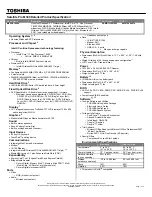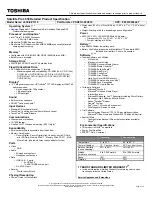
Computer Basics -
13
Expansion Ports
USB (Universal Serial Bus) - USB ports allow you to connect many peripheral devices to your computer (for example:
keyboard, printer, scanner).
IEEE 1394 (FireWire) - An IEEE 1394 port (aka FireWire™ or i.LINK) allows you to connect high-speed digital devices
to your computer, such as digital video cameras, external hard disk drives, or scanners.
ExpressCard - This slot allows you to use an ExpressCard/34 or ExpressCard/54 expansion card.
Note:
It is not possible to use a PC Card device in an ExpressCard slot.
eSATA - An eSATA port allows you to connect a compatible external storage device (usually a hard disk drive) with a
high-speed SATA connection.
Display and Audio Ports
VGA Port - Connect to a monitor with a VGA port. The appropriate cable is usually included with the monitor.
DVI Port - Connect to a monitor with a DVI (Digital Video Interface) port. The appropriate cable is usually included
with the monitor.
Note:
Many monitors use a 15-pin analogue connection, so you may need to purchase an adapter or a DVI-to-Analogue
cable.
S-Video (TV-Out) Connection - An S-Video TV-Out port allows you to connect a compatible television.
HDMI (TV-Out) Connection - An HDMI TV-Out port allows you to connect a compatible display device (such as a
high-definition television) with a single, easy-to-use connector.
Caution:
If you want to use your television's speakers, you must change the audio output or connect the
Line-Out port of your computer to your television (or a speaker system).
Line-Out - Lets you plug in stereo headphones or powered speakers. Plugging in an audio device disables any
built-in speakers.
Microphone - Allows you to connect an external microphone for mono recording or amplification through the
unit. Plugging in an external microphone disables the built-in microphone.
Other Connectors
Memory Card Reader - Memory cards are used to store and transfer data by a wide selection of digital cameras,
PDAs, MP3 players and mobile phones (see page 9).
TV Tuner - Allows you to connect an aerial and watch analogue or digital television on your computer (see page 20).
An adapter may be required to connect to an aerial - if your computer features two TV tuner ports, use a splitter
cable to connect both ports to an aerial.
Note:
The TV tuner must be compatible with signals in your area.
AC Adapter (DC In) - Lets you attach the computer to the the supplied AC adapter. The computer requires a Packard
Bell-certified adapter.
Other Features
Remote Control Receiver - The remote control receiver (Commercial IR) allows you to control the media functions of
your computer from a distance when used with a compatible remote control (optional).
Caution:
The sensor is not an 'full' IR port and can only receive signals from a remote control. It cannot be
used to communicate with other devices, such as mobile telephones.
Kensington Lock Fixture - This fixture allows you to attach a Kensington security lock or other compatible lock to
protect your computer from theft.














































